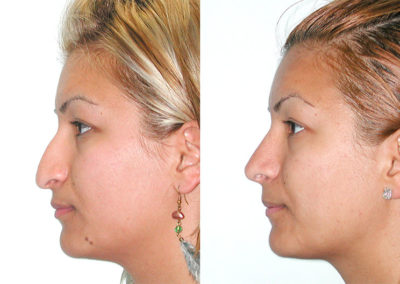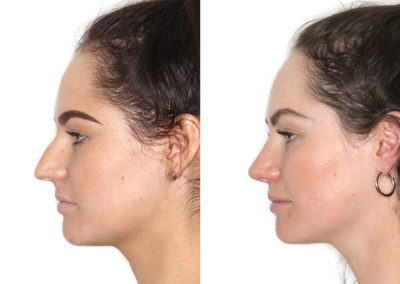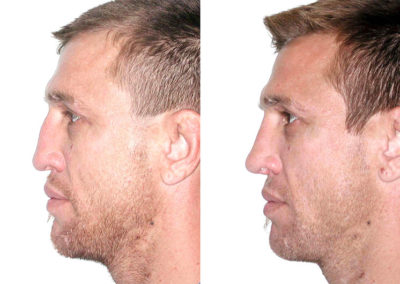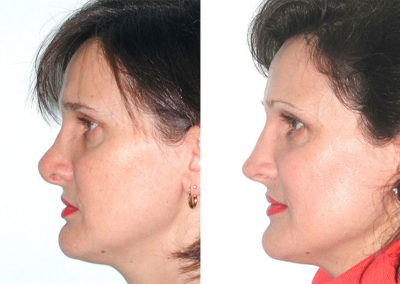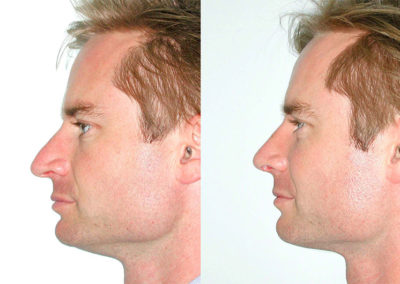Rhinoplasty Explained
Are you unhappy with your nose? Perhaps you have difficulty breathing. Perhaps you are dissatisfied with your natural facial symmetry. Perhaps you sustained an injury that has left your nose with some unwanted imperfections. For these and many other problems, rhinoplasty might be the solution.
“Nose surgery can change many things about the central feature of your face, from its size to its width and profile, to its functionality,” explains Dr George Marcells.
Here’s what you need to know now about this popular, face-changing surgery that is often simply called a “nose job,” but is so much more…
What Is Rhinoplasty?
The term rhinoplasty is derived from the Greek, which means “changing the shape of the nose.” It is a surgical procedure that is performed to:
Correct a structural deformity
Improve appearance
Correct breathing difficulties
“A deviated septum is a common problem,” explains Dr Marcells. The septum is the inner wall between nostrils, composed of bone and cartilage. Ideally, the septum is straight, creating passageways of equal size on each side of the nose. “A deviated septum can causes problems with airflow through the nose,” says Dr Marcells.
Rhinoplasty is a technically challenging surgery. The nose has a complex structure and individual healing considerations are varied and equally complex, making it extremely difficult for even expert surgeons to get the job done right. For this reason nearly 10-20% of patients may need revision rhinoplasty.
What Is Revision Rhinoplasty?
Revision Rhinoplasty is surgery performed to:
correct problems that develop after primary rhinoplasty and/or to…
refine results that are not to the patient’s liking
7 Ways a Rhinoplasty Helps Breathing & Beauty
Rhinoplasty is a flexible surgery that can be used to accomplish a variety of goals:
- Remove the bump at the bridge of the nose (known as a dorsal hump)
- Reduce or widen nasal width
- Correct asymmetry in a nose that is misshapen
- Reduce a prominent nasal tip that is bulbous, fatty, and/or disproportionate to other facial features
- Raise a drooping nasal tip so the angle between the lower nose and upper lip is 90 – 105 degrees
- Re-shape aberrations due to nasal injury
- Straighten a crooked nose
An Overview of the Rhinoplasty Process
Rhinoplasty is a complex surgery with a strong aesthetic component. For this reason, it should be performed by an expert facial plastic surgeon with specific experience in nose jobs. “I recommend patients undergo rhinoplasty at a state-of-the-art medical facility where the most modern techniques and tools are available, as well as the best resources to deal with any negative outcomes,” says Dr Marcells.
A preliminary consultation is the first step in the process. During a face-to-face meeting, patients undergo a physical exam, discuss their goals, and learn all there is to learn about the surgery. “Only when a patient has all the facts is he/she in a position to choose whether or not to move forward with surgery,” says Dr Marcells.
Patients have a detailed Nasal Airway assessment which gives objective measures of nasal function.
A CT scan is usually performed to assess the bony architecture of the nose and to help plan the operation
The patient is reviewed with these results at a preoperative consultation where the procedure and recovery are again explained.
Surgical Rhinoplasty Basics
Typically, rhinoplasty surgery includes these four components:
- Anaesthetic and Prep – Most rhinoplasty is performed in a full accredited facility under general anaesthesia with a fully qualified anaesthetist who is responsible for the patient’s safety during the procedure. Once the patient is asleep the face is prepped with an antibacterial solution and the patient is dressed with sterile drapes.
- Access to the nose – Depending on the nature of your procedure, your surgeon may operate wholly inside the nose: endonasal, or else will open the nose by making a small incision in a hard to see place between the nostrils in order to manipulate the skin and soft tissue which cover the bone and cartilage
- Reshaping/Restructuring – During the procedure, the surgeon makes changes to the nose cartilage and bony framework to achieve the desired aesthetic and functional shape
- Closing and Recovery – When the surgery is complete, the surgeon redrapes the skin and tissue and stitches any incisions closed. The nose is then dressed with a splint which helps to protect the nose and minimize swelling. The patient is awakened carefully from the anaesthetic by the anaesthetic team and transferred for observation to the Recovery suite. The patient is usually able to go home 2-4 hours postop but some may prefer to stay in hospital overnight.
Rhinoplasty Nuances: Rhinoplasty vs. Septoplasty
The common phrase “rhinoplasty” is a term which commonly refers to two separate but inter related procedures:
- Septoplasty – an interior surgery that corrects a deviated septum and so straightens the foundation of the nose. This may alleviate breathing problems.
- Rhinoplasty – a reshaping of the external nose for cosmetic and functional reasons
“Often people who want surgery to correct a breathing problem decide to have an aesthetic rhinoplasty at the same time,” reports Dr Marcells. “This allows them to improve their breathing as well as correct any physical manifestations such as crooked nose or a bump on the nose or a droopy tip.”
Different Techniques for Rhinoplasty
Primary rhinoplasty is the initial surgical procedure performed on the nose. There are two approaches that surgeons use:
- Open Rhinoplasty – A small incision is made in an inconspicuous place in the columella, the vertical strip of skin separating the nostrils. The surgeon elevates the skin and soft tissue off the underlying structures of the nose to reveal the nasal anatomy. “The greatest advantage of this technique is that it allows the surgeon to better visualize the nose and make more definitive and precise changes,” reports Dr Marcells.
- Closed Rhinoplasty – In this surgical approach, surgeons make incisions within the nose. The skin of the nose is then separated from the supporting framework of cartilage and bone, allowing them to be reshaped, augmented or rearranged to achieve the desired profile. “Closed rhinoplasty may be less invasive than the open procedure but it may be hard to achieve predictable results.” Dr Marcells. often uses this approach for minor revisions.
What Is Non-Surgical Rhinoplasty?
Non-surgical rhinoplasty is a relatively painless, “lunchtime” treatment that involves the use of dermal fillers. The injections take just a few minutes, and provide immediate results.
“Dermal fillers are an excellent option for patients who want to make certain changes to their nose without a surgical nose job,” says Dr Marcells, “but the treatment is not for everyone.” Patients with breathing problems and those who want to make a significant reduction in the shape of their nose will not be helped by dermal fillers. “They need internal structural correction,” explains Dr Marcells. You can also not make a lerge nose smaller dy adding volume to it with fillers.
There have also been cases of nasal skin necrosis form dermal fillers as well as blindness.
Can Any Surgeon Perform Rhinoplasty?
No. Rhinoplasty is a challenging operation that is best performed by a facial plastic surgeon who is specifically experienced with the ins-and-outs of nasal surgery. “Rhinoplasty doesn’t always have a standard plan or set order of steps, so surgeons must be prepared to tailor each operation to the needs of the patient,” explains Dr Marcells.
Furthermore, swelling and the placement of local anaesthetic can distort the nose during surgery, hiding many of the subtle changes made. “An under-trained surgeon simply does not have the knowledge or experience to understand this and may end up over-correcting the nose,” says Dr Marcells.
There are also multiple decision making steps during the procedure and it takes many years of experience and judgement to get these right.
Rhinoplasty Consultation Facts
Before you can say “Yes!” to rhinoplasty, you will need to meet with your surgeon to discuss your surgery. At a preliminary consultation with Dr Marcells you will discuss
- Your surgical goals with regard to both nasal appearance and function
- Any previous nose surgeries or trauma you have had
- Your medical history
- Pre-existing conditions
- Risk factors
- The medications you take
- Your lifestyle
Armed with the facts, Dr Marcells will then:
- Do a physical exam and assess your face
- Take photographs
- Perform computer simulation of the photographs to give realistic expectations of the expected oucomes
- Discuss the options he feels will help you achieve your goals
- Recommend a course of treatment
- Discuss likely outcomes, risks, and potential complications
“A consultation is all about you,” says Dr Marcells. “It’s the time to ask questions and get answers to all your questions, no matter how small.” He urges patients to avoid any surgeon who rushes through a consultation or makes them feel pressured or uncomfortable.
Questions to ask Your Rhinoplasty Surgeon
- Where did you get your degree?
- What professional societies do you belong to?
- Are you specifically trained in the field of facial plastic surgery?
- How many years of training have you had?
- Do you have hospital privileges? If so, where?
- Am I a good candidate for this procedure?
- What will be expected of me to get the best results?
- Where will you perform my procedure?
- What surgical techniques are recommended for me?
- How long of a recovery period can I expect?
- Will I need help during my recovery?
- Are risks and complications associated with my procedure?
- How can I expect my nose to look over time?
- What happens if I am dissatisfied with the cosmetic or functional outcome of my nose surgery?
- Do you have before-and-after photos I can look at?
How Do I Know What I’m Going to Look Like?
There are key factors that determine the final results of a rhinoplasty
- The skill of the surgeon
- The patient’s existing nasal structures
- The clarity of communication between doctor and patient
“No one can predict a surgical outcome with certainty,” says Dr Marcells. “Characteristics that are unique to each individual patient, from the thickness of skin over the nose to a patient’s interior nasal architecture will affect the end results of each rhinoplasty procedure.” For these reasons, managing expectations and having realistic goals are extremely important aspects of the cosmetic surgery process.
Profile of an Ideal Rhinoplasty Patient
An excellent candidate for rhinoplasty:
- Is at the age when facial growth is complete (usually after 15)
- Is physically healthy
- Is not suffering from body dysmorphia
- Has realistic expectations
- Understands the limits of the procedure
Advance Planning for Post-Rhinoplasty Needs
Once your surgery is scheduled, you should begin to make plans for after-care. In the first days following your surgery, you may be tired, forgetful, and even impaired judgment. As soon as you have a date for surgery:
- Arrange for someone to drive you home after your procedure
- Arrange for someone to stay with you for a night or two
- Pick up prescription medications before you need them
How a Rhinoplasty Patient Prepares for Surgery
Rhinoplasty is a team effort, and you need to play to win. Be sure you follow your surgeon’s instructions, which are likely to include:
- No eating or drinking after midnight the night before your procedure
- No smoking for one month prior to surgery
- No alcohol one week before surgery
- Stop taking medications or supplements which may cause bleeding or delayed healing (your doctor will tell you which ones)
“Many of these recommendations are related to good circulation, which is essential to healing,” explains Dr Marcells. Some surgeons may prescribe homeopathic therapies before your rhinoplasty, such as arnica (a herb that can minimise bruising). Others prescribe steroids before rhinoplasty to decrease the initial swelling.
What Happens During Rhinoplasty Surgery
In preparation for surgery, the patient’s faced is washed thoroughly. A general anaesthesia will be administered and monitored by a trained and highly experienced anaesthetist. What happens next depends on whether the surgeon will be performing a closed or open rhinoplasty. Incisions will be made inside or outside the nose.
Cartilage or soft tissue grafting may be used to add shape to a small or narrow or crooked nose. To reshape the nasal bones if they are crooked or wide or have a hump Dr Marcells uses a piezo-electric machine. This device uses high frequency ultrasound to cut and reshape the bone. This is a great advancement over the traditional crude tools of chisels and file which many surgeons still use today and are may be very inaccurate.
Once the reshaping is complete, the incisions are closed and splints are inserted into the nose. “This helps the nose retain its new shape and reduces bleeding as well as allowing the patient to breathe postop.” explains Dr Marcells. The nose is then taped and a small external cast is applied. “This is vital to help maintain the new shape during the first phase of healing and reduce swelling,” notes Dr Marcells.
Thanks to advancements in techniques, rhinoplasty is now an outpatient procedure. Patients no longer have to stay overnight in hospital and can go home after waiting for the effects of the anaesthesia to wear off usually over 2 – 4 hours. However patients do have the option to stay overnight if desired.
Tell Me about Recovery from Rhinoplasty
Although it is an outpatient procedure, rhinoplasty does require some healing time. Dr Marcells requires patients take 14 days off from work and physical activities following surgery. “It’s wise to be good to your body and treat it with care while the swelling subsides,” he remarks.
To make the most of recovery time, it is recommended that rhinoplasty patients:
- Use an ice dressings to reduce swellingFollow their surgeon’s instructions for pain management
- Eat foods that are soft and easy to chew
- Sleep with their head elevated to reduce swelling and bruising
- keep their head out of water during showers or baths so as not to wet the dressing
- Brush their teeth gently so you do not agitate the upper lip or nose
- Refrain from blowing their nose
- Change bandages regularly as instructed by their surgeon
“Even when you start to feel better, it’s important not to overdo things,” cautions Dr Marcells. In the weeks following rhinoplasty, he tells patients to:
- Do not engage in exercise or strenuous activity until you get an all-clear from your surgeon
- Apply a sunscreen with SPF 30 or higher whenever you go outdoors
- Cut back on your sodium
- Do not wear glasses or sunnies for at least a month or you will risk denting your nose
When patients follow their after-care instructions, the majority of the swelling will go down in ten to fourteen days.
How Soon Will I Be Able to See a Change in My Nose?
Your nasal splint will likely be removed after 2weeks, and you should immediately begin to see major changes. The nose usually looks good at this stage: better than preop, but may still have some significant swelling.
The majority of the swelling disappears within 1-3months, but slight swelling may persist for up to 1-2 after surgery. Dr Marcells urges patients to stay calm if their noses initially look asymmetrical or imperfect. “It takes time for your body to recover from surgery,” he explains. “Just be patient and in a few weeks, you’ll start to see a new you.”
Rhinoplasty: Is It Worth the Risk?
It is important to understand risks associated with this procedure. They include:
- Infection
- Bleeding
- Unresolved breathing issues (nasal obstruction)
- Dissatisfaction with aesthetic results
- Additional touch-up surgeries
- Septal perforation
- Complications due to anaesthesia
“Be sure to work with a qualified facial plastic surgeon that has extensive experience performing rhinoplasty,” says Dr Marcells. “That will significantly reduce the risk of problems.”
How Much Does Rhinoplasty Cost?
Factors that go into the total cost of rhinoplasty surgery include:
- Surgeon’s fees – This can range from $5,000 to $20000 (AUD) depending on the exact procedure, the experience of the surgeon, and even the Australian state you’re in
- Anaesthetist’s fees – $1-3000 (AUD) depending on the length of time of the procedure
- Hospital Costs – $2-6000 (AUD) depending on the length of time of the procedure
If you decide you need an additional facial procedure(such as chin augmentation or eyelid surgery), combining the two procedures into one surgery may be less expensive than if you have them separately.
Beyond the costs above, other factors that can affect costs include:
- Medical tests
- Additional procedures
- Prescription medication
Are Rhinoplasty Costs Covered by Insurance?
Insurance does not typically cover the cost of cosmetic procedures. However, if the purpose of your rhinoplasty is to improve breathing, it is considered medically necessary and may be covered or partly by Medicare and your Private insurance.
Medicare has recently required a patient questionnaire about their breathing be completed before considering them eligible for any rebate.

